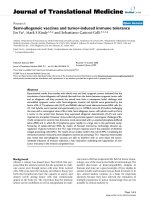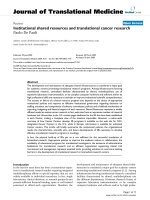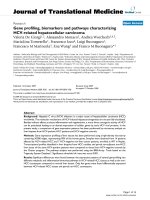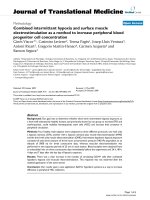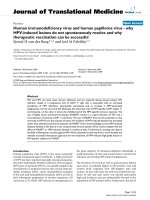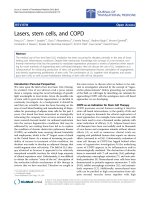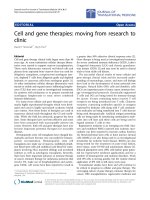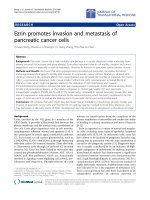Báo cáo hóa học: " Nanospheres: Preparation, Characterization, and Their Adsorption Properties" docx
Bạn đang xem bản rút gọn của tài liệu. Xem và tải ngay bản đầy đủ của tài liệu tại đây (334.88 KB, 6 trang )
NANO EXPRESS
Hollow Sodium Tungsten Bronze (Na
0.15
WO
3
) Nanospheres:
Preparation, Characterization, and Their Adsorption Properties
Jing Hou Æ Guanke Zuo Æ Guangxia Shen Æ
He Guo Æ Hui Liu Æ Ping Cheng Æ
Jingyan Zhang Æ Shouwu Guo
Received: 23 April 2009 / Accepted: 1 July 2009 / Published online: 17 July 2009
Ó to the authors 2009
Abstract We report herein a facile method for the prepa-
ration of sodium tungsten bronzes hollow nanospheres using
hydrogen gas bubbles as reactant for chemical reduction of
tungstate to tungsten and as template for the formation of
hollow nanospheres at the same time. The chemical com-
position and the crystalline state of the as-prepared hollow
Na
0.15
WO
3
nanospheres were characterized complementa-
rily, and the hollow structure formation mechanism was
proposed. The hollow Na
0.15
WO
3
nanospheres showed large
Brunauer–Emment–Teller specific area (33.8 m
2
g
-1
),
strong resistance to acids, and excellent ability to remove
organic molecules such as dye and proteins from aqueous
solutions. These illustrate that the hollow nanospheres of
Na
0.15
WO
3
should be a useful adsorbent.
Keywords Sodium tungsten bronze Á
Hollow nanosphere Á Adsorption property
Introduction
Hollow structure materials exhibit usually extraordinary
adsorbing capacities to a wide range of species (i.e., metal
ions, organic molecules, and biomolecules) and have found
practical applications in catalysis [1, 2], water treatment
[3], and drug delivery [4]. The hollow nanospheres,
because of their unique physical and chemical properties,
have attracted more significant interest during the last few
years [5–9]. Up to now, several synthetic strategies have
been developed, and a range of hollow nanospheres,
especially metal oxides and sulfides, have been fabricated
[3, 6, 8, 10–12], but it is still challenging to develop simple
and reliable synthetic methods for hollow nanospheres with
diverse chemical compositions, desired chemical/physical
stabilities, and controlled size and shell structures (shell
thickness and porosity), which are critical for their prac-
tical applications.
Sodium tungsten bronzes (Na
x
WO
3
,0\ x B 1), besides
their unique electronic/electric properties that vary greatly
with their compositions [13–17], have inert chemical prop-
erties, such as insolubility in water and resistance to most
acids except hydrofluoric [18], which make Na
x
WO
3
promising for use in many extreme chemical cases. Nano-
sized Na
x
WO
3
, predictably, should have more enriched
properties differing from that of the corresponding bulk
materials and might find more novel applications, but have
barely been explored [19]. We report herein a facile strategy
for the fabrication of hollow nanospheres of sodium tungsten
bronzes, Na
x
WO
3
, and their potential applications in water
treatment. The fabrication, including the control on sizes of
Electronic supplementary material The online version of this
article (doi:10.1007/s11671-009-9383-x) contains supplementary
material, which is available to authorized users.
J. Hou Á G. Shen Á P. Cheng Á S. Guo (&)
National Key Laboratory of Nano/Micro Fabrication Technology,
Key Laboratory for Thin Film and Microfabrication of the
Ministry of Education, Research Institute of Micro/Nano Science
and Technology, Shanghai Jiao Tong University,
200240 Shanghai, People’s Republic of China
e-mail:
J. Hou
School of Materials Science & Engineering, East China
University of Science and Technology, 200237 Shanghai,
People’s Republic of China
G. Zuo Á H. Guo Á H. Liu Á J. Zhang (&)
School of Pharmacy, East China University of Science and
Technology, 200237 Shanghai, People’s Republic of China
e-mail:
123
Nanoscale Res Lett (2009) 4:1241–1246
DOI 10.1007/s11671-009-9383-x
the spheres and hollow feature of the hollow Na
x
WO
3
nan-
ospheres, was achieved through reduction of aqueous
sodium tungstate (Na
2
WO
4
) solution by sodium borohydride
(NaBH
4
) powder under well-controlled pH and temperature.
The chemical composition, crystalline state, size, and mor-
phology of the as-prepared hollow Na
x
WO
3
nanospheres
were characterized complementarily using scanning electron
microscopy(SEM), transmission electron microscopy (TEM,
including HRTEM), energy dispersive spectrum (EDS),
X-ray photoelectron spectroscopy (XPS), and X-ray powder
diffraction (XRD). Their application in the removal of
organic molecules from water was illustrated using different
molecules, such as Coomassie brilliant blue, Albumin
Bovine, and Lysozyme.
Experimental
Sodium tungstate, sodium borohydride, hydrochloric acid
(37%), and ethanol were purchased from Sinopharm
Chemical Reagent Co., Ltd. (Shanghai, China) and used as
received. Coomassie Brilliant blue, Lysozyme, and Albumin
Bovine were from Sino-American Biotechnology Co.
(Shanghai, China). Pure water (electric resistance of
18.2 MX cm
-1
) was produced through an HF Super NW
water purification system (Heal Force Co. Shanghai, China).
A typical procedure for the preparation of hollow Na
0.15
WO
3
nanospheres is as follows: 40 mL of 0.25 M Na
2
WO
4
aqueous solution was put in a 250 mL flask and the pH of the
solution was adjusted to 6.8 using concentrated HCl (37%).
Then, 0.025 mol of NaBH
4
powder was added gradually into
the Na
2
WO
4
solution, and the mixture was stirred at room
temperature (*25 °C) for 2 h. After the reaction, the brown
precipitate was separated from the reaction system by cen-
trifugation, washed three times with pure water and two
times with ethanol, and finally dried at 80 °C under a vac-
uum. Solid Na
0.15
WO
3
nanospheres were prepared under
almost the same conditions used above except that the
reaction temperature was 100 °C and that the NaBH
4
pow-
ders must be added step-by-step because the reaction at
100 ° C takes place vigorously.
Coomassie Brilliant Blue and the proteins adsorption
experiments were carried out at room temperature. The
Na
0.15
WO
3
was first dispersed into water or buffer; the stock
solutions of Coomassie Brilliant blue or proteins were then
added to the Na
0.15
WO
3
suspension and incubated on the
shaker. UV–vis absorption spectra of Coomassie Brilliant
blue and proteins in the supernatant were recorded at dif-
ferent time intervals to follow the adsorption process. The gel
electrophoresis was run on a DYY-6C electrophoresis sys-
tem (Liuyi Electrophoresis Co., Beijing, China). The stan-
dard 15% SDS polyacrylamide gel was used and was run
under constant voltage of 50 mV.
Scanning electron microscopy images were acquired on
a SIRION 200 field emission scanning electron microscope
(FEI Company, USA). TEM images and energy dispersive
spectra (EDS) were taken on a JSM-2010 transmission
electron microscope (JEOL Ltd., Japan) operated at
200 kV. The powders of Na
0.15
WO
3
nanospheres were first
suspended in water and then transferred on to silicon
substrates or copper TEM grids for the SEM and TEM
measurements, respectively. XRD patterns were recorded
on a D/MAX 2200/PC diffractometer (Rigaku Corporation,
Japan) using Cu Ka radiation, k = 1.54 A
˚
. XPS measure-
ment was performed on an Axis Ultra DLD instrument
(Kratos Analytical, UK) using a monochromatized Al (Ka)
source. UV–vis absorption spectra were recorded on a
UV-2550 spectrometer (Shimadzu Corporation, Japan).
The Brunauer–Emment–Teller (BET) specific area was
measured on ASAP 2010 M/C surface area and porosi-
metry analyzer (Micromeritics Instrument Corporation,
USA) based on N
2
adsorption.
Results and Discussion
In general, the bulk sodium tungsten bronzes can be pre-
pared through the following chemical reaction [20–23]:
Na
2
WO
4
þ NaBH
4
þð3 ÀxÞH
2
O ! Na
x
WO
3
#þNaBO
2
þð2 ÀxÞNaOH þð4 À0:5xÞH
2
"
In the reaction, the hydrogen generated from the hydrolysis
of NaBH
4
under acidic reaction condition was partially
consumed to reduce tungstate to tungsten, and the rest was
released from the reaction system to the air [24]. Therefore,
in practice, to prevent a rapid loss of hydrogen and to
enhance the reduction ability of NaBH
4
, the aqueous solu-
tions of Na
2
WO
4
and NaBH
4
were mixed first, and the
initial pH of mixture solution was maintained at 11 or
above. The Na
2
WO
4
reduction was initiated subsequently
by adjusting the pH of the mixture down below 7 by adding
acid, such as HCl. Thus, there were not too many hydrogen
gas bubbles accumulated in the reaction system, the loss of
the hydrogen gas could be suppressed, and powder of bulk
sodium tungsten bronzes was obtained finally. In this work,
instead of mixing two pre-prepared solutions, the reaction
was conducted by adding the NaBH
4
powder directly into
the Na
2
WO
4
aqueous solutions. However, we found that
when the pH of the Na
2
WO
4
aqueous solution is above 10,
the reaction took place very slow; under the acidic condi-
tion, pH \ 6, the NaBH
4
was hydrolyzed rapidly and the as-
generated hydrogen bubbles escaped from the reaction
system severely. Hence, in a typical procedure of preparing
Na
x
WO
4
nanospheres in the work, Na
2
WO
4
aqueous solu-
tions with pH near to neutral (typically, 6.9–7.2) were
prepared first, and NaBH
4
powder was then added gradually
1242 Nanoscale Res Lett (2009) 4:1241–1246
123
into the Na
2
WO
4
solutions under moderate stirring at room
temperature (*25 °C). The total amount of NaBH
4
added
was usually three times of Na
2
WO
4
(molar ratio) to ensure
the reduction of tungstate to tungsten. After completion of
the reaction, the solid product was collected by centrifu-
gation and was washed thoroughly using pure water and
ethanol, and finally dried at 80 °C under a vacuum
(0.01 Torr).
Scanning electron microscopy image, in Fig. 1a, shows
that the solid products are nanospheres with sizes ranging
from a few 10 to 200 nm in diameter. As pointed out with
arrows in Fig. 1a, some broken nanospheres have a vacant
interior structure, and the shell thickness of the broken
nanospheres is about 25 nm. This provides us with a hint
that the as-obtained nanospheres might have a hollow
structure. To confirm this assumption, the nanospheres
were subjected to TEM measurement. As depicted in
Fig. 1b, the TEM image of each nanosphere possesses the
dark edge and bright center illustrating unambiguously
their hollow nature. The averaged shell thickness of hollow
spheres measured from the TEM images is *25 nm. This
is in full agreement with the data (*25 nm) measured on
SEM images of the broken nanospheres (indicated via the
dark arrows in Fig. 1a). In addition, on the SEM image
(Fig. 1a), circular nanoholes (*20–40 nm in diameter)
were observed on the shells of some nanospheres implying
the formation of the open-shell hollow structures. It is
impossible to take the images of the hollow nanospheres
from all the directions at the same time, so the distribution
of the nanoholes is unknown at the moment for us.
The chemical compositions and crystallinity of the as-
synthesized hollow Na
x
WO
3
nanospheres were character-
ized complementarily using XRD, HRTEM, XPS, and
EDS. As illustrated in Figure S1, the XRD patterns dem-
onstrated that the hollow Na
x
WO
3
nanospheres are amor-
phous. This was verified independently by the HRTEM
image (see Figure S2) on which there is no crystal lattice
observed. Figure 2 shows the XPS spectrum of W in the
hollow Na
x
WO
3
nanospheres. The two major W 4f
7/2
and
4f
5/2
peaks centered at 35.75 and 37.58 eV are assigned to
the W
6?
bound to oxygen. The corresponding binding
energies of two relatively weaker W 4f
7/2
and 4f
5/2
peaks,
33.75 and 35.95 eV, are in agreement with the expected
values for W
5?
bound to oxygen [25]. The ratio of W
5?
to
W
6?
estimated from the integrated areas of the afore-
mentioned W 4f XPS peaks is about 0.18 [means W
5?
/
(W
5?
? W
6?
) = 0.18/(0.18 ? 1) & 0.15]. This illus-
trates that the chemical formula of the hollow nanospheres
should be Na
0.15
WO
3
. The EDS results acquired from the
same hollow nanospheres were depicted in Figure S3. The
as-determined Na content is of *0.15 (atomic ratio to W),
which is in full agreement with the XPS result.
Several mechanisms have been proposed for the for-
mation of the nanosized hollow structures. The Kirkendall
effect (simply be interpreted as an interfacial solid-state
chemical reaction) has been widely used to explain the
Fig. 1 a FESEM image of
hollow Na
0.15
WO
3
nanospheres.
The arrows indicate the broken
hollow nanospheres from which
the thickness, *25 nm, of the
shell of the hollow nanospheres
was estimated. b TEM image of
the hollow Na
0.15
WO
3
nanospheres. The dark edge and
bright center character of the
TEM image of the nanospheres
reveal the formation of the
hollow structure
Fig. 2 XPS spectra of W (4f
7/2
and 4f
5/2
) in the hollow Na
0.15
WO
3
nanospheres
Nanoscale Res Lett (2009) 4:1241–1246 1243
123
formation of hollow structures via solid substance as the
reactant as well as the ‘‘hard template’’ [3, 26, 27]. More
recently, a gas–liquid interface aggregation mechanism
was introduced to interpret the formation of hollow nano-
structures with the gas bubble as a ‘‘soft template’’ [9]. The
gas–liquid interface aggregation mechanism consists typi-
cally of three steps: the nanoparticle formation, diffusion,
and aggregation. Differently, in our case, we believe that
the hydrogen gas bubbles accumulated in the reaction
system play dual roles: reducing chemically the tungstate
to tungsten and guiding the formation of hollow Na
0.15
WO
3
nanospheres. During the reaction, Na
2
WO
4
was reduced to
Na
0.15
WO
3
at the interfaces of hydrogen gas bubbles and
reaction solution, and the formed Na
0.15
WO
3
condensed in
situ at the interface forming the hollow structure. This is
different from the aforementioned gas–liquid interface
aggregation procedure, but more similar to Kirkendall effect.
To confirm the indispensability of the hydrogen gas bubbles
as templates for the formation of hollow structure, the
temperature for Na
2
WO
4
reduction with NaBH
4
was raised
from 25 to 60, 80, and 100 °C while other reaction condi-
tions were kept the same. Generally, high temperature
accelerates the gas release from the reaction solution, thus
would affect the amount of the hydrogen gas bubbles
accumulated in the reaction solutions. As expected, the
percentage of solid sodium tungsten bronzes nanoparticles in
the product was increased with the increase in temperature.
At 100 °C, only solid sodium tungsten bronzes nanoparticles
were obtained as shown in Fig. 3. Additionally, during the
course of the reaction, some hydrogen gas bubbles in the
reaction solution unavoidably escaped from the solution
before they were fully covered by Na
0.15
WO
3
, which results
in the formation of the holes on the hollow shells, see
Fig. 1a.
The metal oxide hollow nanoparticles, such as a- and
c-Fe
2
O
3
,Fe
3
O
4
, MnO
2
, and TiO
2
, have been used as ab-
sorbents for removing the pollutants from water [1–4],
however, due to their reactions with acids, most of them
cannot be stable in acidic water. Thus, the removal of
pollutants from water using the metal oxides was usually
performed under neutral or weak basic condition. Differ-
ently, the as-prepared Na
0.15
WO
3
nanospheres are resis-
tance to most acids. We found that after being immersed in
water with pH = 2 for 2 days, the size and the hollow
structure of the Na
0.15
WO
3
nanospheres were still pre-
served well (Figure S5). Nitrogen adsorption isotherm
showed that the BET specific area of hollow Na
0.15
WO
3
nanospheres (Fig. 1) is 33.8 m
2
g
-1
, which is much larger
than that (9.3 m
2
g
-1
) of the same size solid Na
0.15
WO
3
nanospheres (Fig. 3). The resistance to acids and large
specific area of the as-obtained hollow Na
0.15
WO
3
nano-
spheres suggest that the hollow Na
0.15
WO
3
nanospheres
might be an optimal adsorbent to remove organic pollutants
from acidic waste water. To test this assumption, in a
Fig. 3 a FESEM and b TEM
images of solid Na
0.15
WO
3
nanospheres
Fig. 4 Adsorption abilities of the hollow and solid Na
0.15
WO
3
nanospheres to Coomassie Brilliant blue. Y axis is the percentage of
Coomassie Brilliant blue adsorbed at the corresponding incubation
time
1244 Nanoscale Res Lett (2009) 4:1241–1246
123
typical experiment, 100 mg of hollow Na
0.15
WO
3
nano-
spheres was suspended in 2 mL, 60 lg/mL of Coomassie
Brilliant blue (a common dye) aqueous solution with
pH = 2. The concentration variation of the Coomassie
Brilliant blue in the supernatant as a function of adsorption
time was followed using UV–vis spectroscopy. As shown
in Fig. 4, 87% of the Coomassie brilliant blue was adsor-
bed within 300 min by the hollow Na
0.15
WO
3
nanospheres
at room temperature. For comparison, a similar experiment
was performed with the solid sodium tungsten bronzes
nanoparticles as adsorbent. As depicted in Fig. 4, after
300 min, only 50% of the Coomassie Brilliant blue was
adsorbed by the solid sodium tungsten bronzes nanoparti-
cles. Considering that the specific area of the hollow
Na
0.15
WO
3
nanospheres is almost three times of that of the
solid Na
0.15
WO
3
nanospheres, we, thus, believe that the
surface absorption should play main roles for the removal
of the dye molecules from water. In order to investigate the
effects of pH value of waste water on the removal capacity
of the hollow Na
0.15
WO
3
nanospheres, the pH values of the
Coomassie Brilliant blue aqueous solutions were varied
from 1 to 6, but no obvious influences were observed.
Hollow Na
0.15
WO
3
nanospheres could also be used to
remove biomacromolecules from water. The adsorption
abilities of the hollow Na
0.15
WO
3
nanospheres to Albumin
Bovine (MW, 66 kDa) and Lysozyme (MW, 14.3 kDa)
were determined using gel electrophoresis and UV–vis
spectroscopy. Figure 5a presents the images of sodium
dodecyl sulfate polyacrylamide gel electrophoresis (SDS–
PAGE) of mixture (Albumin Bovine to Lysozyme is 1:3 in
weight) of two proteins before and after incubation with the
hollow Na
0.15
WO
3
nanospheres for 5 and 15 min, respec-
tively. Lane 1 presents the as-mixed two proteins. Lane 2
and 3 show the supernatants after incubation with the
hollow Na
0.15
WO
3
nanospheres for 5 and 15 min, respec-
tively. As seen from the intensities of the protein lanes,
after 15 min adsorption, *50% of Albumin Bovine and
*95% of Lysozyme were adsorbed. The protein concen-
tration of each samples, before and after the adsorption,
were also precisely determined using UV–vis spectros-
copy. The results are shown in Fig. 5b. After 15 min
incubation, 95% of Lysozyme was adsorbed, while only
50% of Albumin Bovine was adsorbed by the same amount
of the hollow Na
0.15
WO
3
nanospheres. This is consistent
with the gel electrophoresis results. Such adsorption ability
difference suggested that the large size protein could
mainly be adsorbed on the outer surface of the hollow
Na
0.15
WO
3
nanospheres, while the small size protein might
be adsorbed on both the outer and inner surfaces of the
hollow nanospheres. Additionally, the different adsorption
abilities to the proteins with different sizes could also be
caused by the surface charge and structure difference of the
proteins themselves. Nevertheless, the facts that Coomassie
Brilliant blue and proteins with different sizes could be
adsorbed by the hollow Na
0.15
WO
3
nanospheres suggest
that the hollow Na
0.15
WO
3
nanospheres should be poten-
tially useful in water treatment.
Conclusions
The hollow sodium tungsten bronze, Na
0.15
WO
3
, nano-
spheres have been successfully fabricated using the
hydrogen gas bubbles as reactant to reduce the tungstate to
tungsten and as template to direct the hollow structure
formation as well. This, to our best knowledge, is the first
Fig. 5 a The image of gel
electrophoresis of Albumin
Bovine and Lysozyme. Lane 1,
the mixture (1:3 in weight)
of the two proteins; Lane 2
and 3, the mixture (1:3 in
weight) of the two proteins after
5 min and 15 min incubation
with hollow Na
0.15
WO
3
nanospheres, respectively.
b UV–vis spectra of Albumin
Bovine and Lysozyme before
and after incubation with hollow
Na
0.15
WO
3
nanospheres for
15 min
Nanoscale Res Lett (2009) 4:1241–1246 1245
123
example of using hydrogen gas bubbles as reactant and
template at the same time to prepare nanosized hollow
materials, and should provide a general means for prepar-
ing other inorganic nanosized hollow materials. The resis-
tance to most acids and the pronounced removal capacity
of the as-synthesized hollow Na
0.15
WO
3
nanospheres to
small organic molecules and proteins from acidic waste
water should find widespread applications in water treat-
ment. Further studies on tailoring the surface chemistry and
the shell porosity of the hollow Na
0.15
WO
3
nanospheres
would be essential to their practical applications and are
under current investigation.
Acknowledgments This work was supported by the National Basic
Research Program (973 program) of China (No. 2007CB936000), the
National High Technology Research and Development Program (863
program) of China (No. 2006AA04Z309), and the Shanghai Pujiang
Scholarship Program (Nos. 06PJ14025, 06PJ14030).
References
1. A.D. Dinsmore, M.F. Hsu, M.G. Nikolaides, M. marquez,
A.R. Bausch, D.A. Weitz, Science 298, 1006 (2002)
2. J. Yuan, K. Laubernds, Q. Zhang, S.L. Suib, J. Am. Chem. Soc.
125, 4966 (2003)
3. J. Fei, Y. Cui, X. Yan, W. Qi, Y. Yang, K. Wang, Q. He, J. Li,
Adv. Mater. 20, 452 (2008)
4. Y. Zhu, J. Shi, W. Shen, X. Dong, J. Feng, M. Ruan, Y. Li,
Angew. Chem. Int. Ed. 44, 5083 (2005)
5. F. Caruso, R.A. Caruso, H. Mohwald, Science 282, 1111–1114
(1998)
6. J. Liu, D. Xue, Adv. Mater. 20, 2622 (2008)
7. X.W. Lou, C. Yuan, L.A. Archer, Adv. Mater. 19, 3328 (2007)
8. Q. Peng, Y. Dong, Y. Li, Angew. Chem. Int. Ed. 42, 3027 (2003)
9. X. Wang, Q. Peng, Y. Li, Acc. Chem. Res. 40, 635 (2007)
10. J. Huang, Y. Xie, B. Li, Y. Liu, Y. Qian, S. Zhang, Adv. Mater.
12, 808 (2000)
11. S. Kim, M. Kim, W. Lee, T. Hyeon, J. Am. Chem. Soc. 124, 7642
(2002)
12. Y. Ma, L. Qi, J. Ma, H. Cheng, W. Shen, Langmuir 19, 9079
(2003)
13. E.O. Brimji, J.C. Brantey, H. Lorenaz, H. Jellinek, J. Am. Chem.
Soc. 73, 5427 (1951)
14. L.E. Conroy, J. Chem. Educ. 54, 45 (1977)
15. B.A. Raby, C.V. Banks, Anal. Chem. 36, 1106 (1964)
16. S. Raj, H. Matsui, S. Souma, T. Sato, T. Takahashi, A. Chakr-
aborty, D.D. Sarma, P. Mahadevan, S. Osihi, W.H. McCarroll,
M. Geenblatt, Phys. Rev. B Condens. Matter Mater. Phys. 75,
155116 (2007)
17. M.J. Sienko, S.M. Morehouse, Inorg. Chem. 2, 485 (1963)
18. F.A. Cotton, G. Wilkinson, Advanced inorganic chemistry, 5th
edn. (Wiley-Interscience, New York, 1988)
19. J. Wang, G. Liu, Y. Du, Mater. Lett. 57, 3648 (2003)
20. R. Fan, X.H. Chen, Z. Gui, Z. Sun, S.Y. Li, Z.Y. Chen, J. Phys.
Chem. Solids 61, 2029 (2000)
21. A. Manthiram, A. Dananjay, Y.T. Zhu, Chem. Mater. 6, 1601
(1994)
22. C. Tsang, S.Y. Lai, A. Manthiram, Inorg. Chem. 36(/10), 2206
(1997)
23. G.K. Wertheim, M. Campagna, J.N. Chazalviel, H.R. Shanks,
Chem. Phys. Lett. 44, 50 (1976)
24. H.I. Schlesinger, H.C. Brown, A.E. Finholt, J.R. Gilbreath,
H.R. Hoekstra, E.K. Hyde, J. Am. Chem. Soc. 75(1), 215 (1953)
25. O.Y. Khyzhun, J Alloy Compd 305, 1 (2000)
26. H.J. Fan, M. Knez, R. Scholz, K. Nielsch, E. Pippel, D. Hesse,
M. Zacharias, U. Gosele, Nat. Mater. 5, 627 (2006)
27. A.D. Smigelskas, E.O. Kirkendall, Trans. Am. Inst. Min. Metall.
Pet. Eng. 171, 130 (1947)
1246 Nanoscale Res Lett (2009) 4:1241–1246
123
